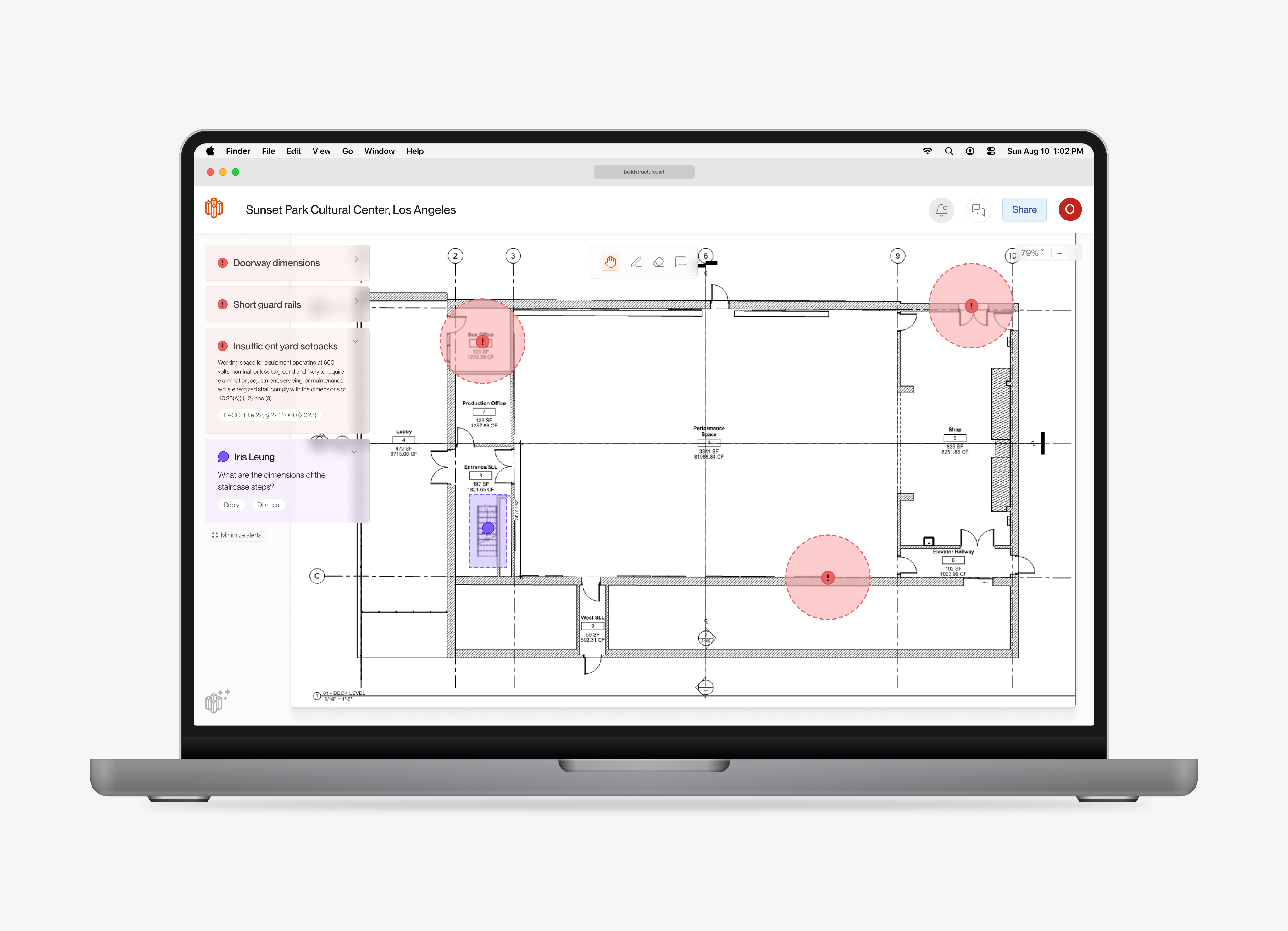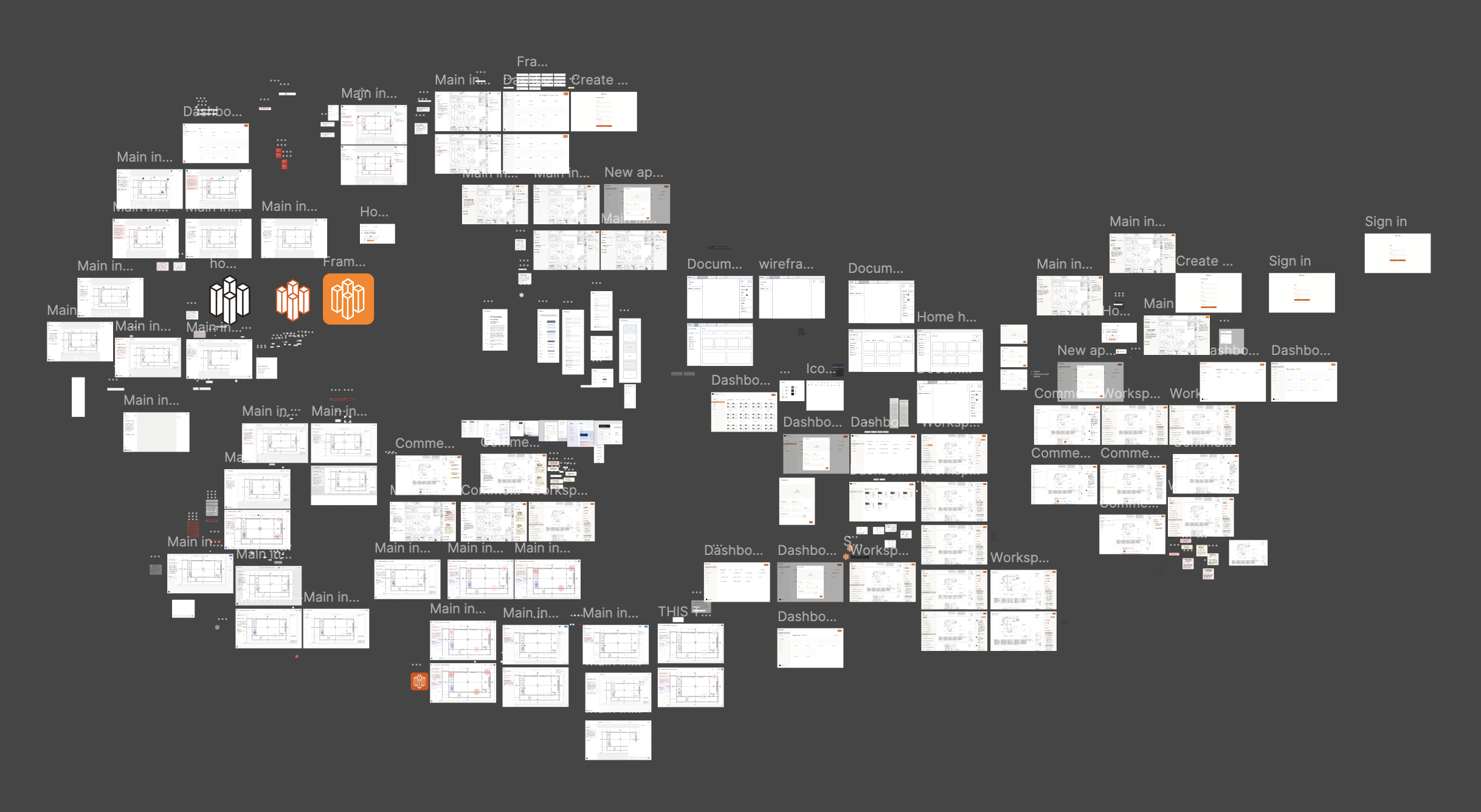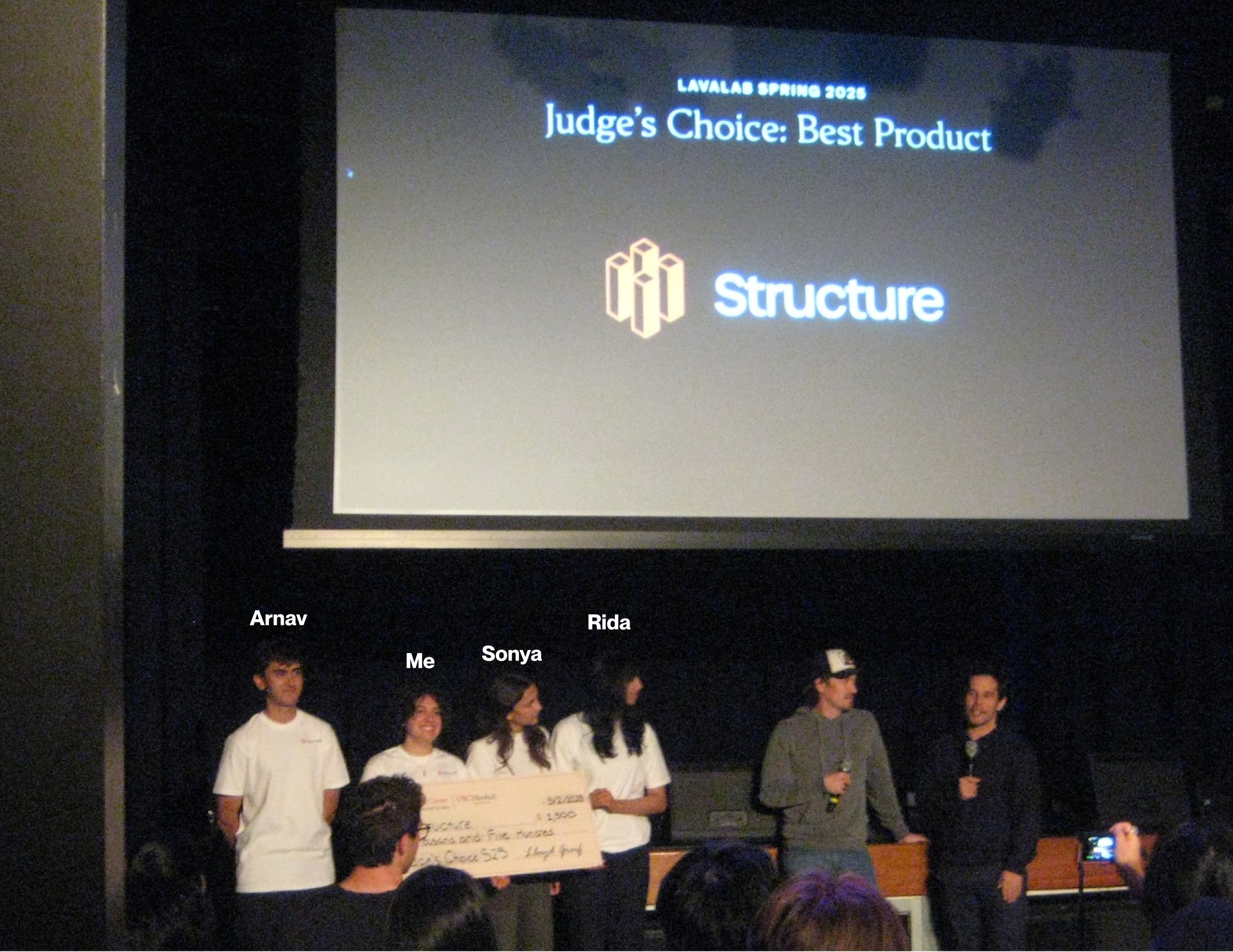
Structure
Co-founder, Head of Design, 2025
Shipping a quality control and compliance co-pilot for architectural drawings in a startup incubator.
Timeline
8 weeks
Role
Co-founder
Head of Design
Team
Arnav Shah (PM)
Sonya Alexis (Dev)
Rida Faraz (Dev)
Olivia Nazari (Designer)
Tools
Figma
Illustrator
Notion
Defining the Problem
Obtaining a city’s approval for architectural drawings is the first step of any construction project to ensure code compliance. Codes vary widely, as they are determined by the state, city, and even district level.
An architect can spend up to 2-3 hours digging on the internet for specific district codes for any given project. Even with this effort, 40% of permit applications are rejected by the city due to unforeseen coding violations, leading to project delays and financial losses.
Working with 2 developers and 1 PM, we built and shipped a quality control and compliance co-pilot for architectural drawings. Structure intends to fill this gap between architects and city officials by detecting coding violations before submission using a visual language model (VLM). Structure goes one step further to connect files to engineers and clients, streamlining the permitting process and connecting team mates.
Understanding the User
In order to compliment an architect’s design process, the interface should prioritize smooth workflow, collaboration, and an intuitive interface.
- How do we ensure clarity and coordination between architects, engineers, and city officials?
- How can we make architecture code more visually digestible?
- The architecture and construction space is old and unchanging; how can we make the interface intuitive for an unchanging industry?
Ideation
Ideation was split into two goals: information architecture and readability.
First ideation focused on laying out architectural codes into clear sections and categories. Next, ideation focused on displaying violations onto drawings in an intuitive manner. Both ideation phases consisted of multiple iterations. Ultimately, clarify and concision was prioritized.

Shipping Product
Shipping the product consisted of creating core V0 feature set, as well as slide deck material for stakeholder pitches.
I partnered with my 2 developers to correlate the features to feasible backend structure. I partnered with my PM to create a compelling and informative slide deck to showcase to stakeholders.
Success and Feedback
Structure was awarded Judge’s Choice: Best Product at LavaLab’s Demo Night. This included a $1,500 investment from 3 VCs.
The interface and product was well-received and included feedback as follows:
- The lightweight interface was thought to be clear yet maintained functionality without cognitive overload.
- The integration of collaborative users encouraged architects to share files with engineers and other teammates.
- The unique user experience and clear art board differentiates this product from others in its ecosystem.
Takeaways
Structure was my first experience working in startup, as well as my first experience fully developing a product from zero.
- Brand identity and product function go hand in hand.
- Users, especially in certain stubborn fields, need to be able to learn an application quickly and easily. Ease of use is especially important here.
- Iteration can take time. Iterate as many times as needed to get the product right.
Thank you to my Structure teammates, and LavaLab for hosting us.


Structure
Co-founder, Head of Design, 2025
Shipping a quality control and compliance co-pilot for architectural drawings in a startup incubator.
Timeline
8 weeks
Role
Co-founder
Head of Design
Team
Arnav Shah (PM)
Sonya Alexis (Dev)
Rida Faraz (Dev)
Olivia Nazari (Designer)
Tools
Figma
Illustrator
Notion
Defining the Problem
Obtaining a city’s approval for architectural drawings is the first step of any construction project to ensure code compliance. Codes vary widely, as they are determined by the state, city, and even district level.
An architect can spend up to 2-3 hours digging on the internet for specific district codes for any given project. Even with this effort, 40% of permit applications are rejected by the city due to unforeseen coding violations, leading to project delays and financial losses.
Working with 2 developers and 1 PM, we built and shipped a quality control and compliance co-pilot for architectural drawings. Structure intends to fill this gap between architects and city officials by detecting coding violations before submission using a visual language model (VLM). Structure goes one step further to connect files to engineers and clients, streamlining the permitting process and connecting team mates.
Understanding the User
In order to compliment an architect’s design process, the interface should prioritize smooth workflow, collaboration, and an intuitive interface.
- How do we ensure clarity and coordination between architects, engineers, and city officials?
- How can we make architecture code more visually digestible?
- The architecture and construction space is old and unchanging; how can we make the interface intuitive for an unchanging industry?
Ideation
Ideation was split into two goals: information architecture and readability.
First ideation focused on laying out architectural codes into clear sections and categories. Next, ideation focused on displaying violations onto drawings in an intuitive manner. Both ideation phases consisted of multiple iterations. Ultimately, clarify and concision was prioritized.

Shipping Product
Shipping the product consisted of creating core V0 feature set, as well as slide deck material for stakeholder pitches.
I partnered with my 2 developers to correlate the features to feasible backend structure. I partnered with my PM to create a compelling and informative slide deck to showcase to stakeholders.
Success and Feedback
Structure was awarded Judge’s Choice: Best Product at LavaLab’s Demo Night. This included a $1,500 investment from 3 VCs.
The interface and product was well-received and included feedback as follows:
- The lightweight interface was thought to be clear yet maintained functionality without cognitive overload.
- The integration of collaborative users encouraged architects to share files with engineers and other teammates.
- The unique user experience and clear art board differentiates this product from others in its ecosystem.
Takeaways
Structure was my first experience working in startup, as well as my first experience fully developing a product from zero.
- Brand identity and product function go hand in hand.
- Users, especially in certain stubborn fields, need to be able to learn an application quickly and easily. Ease of use is especially important here.
- Iteration can take time. Iterate as many times as needed to get the product right.
Thank you to my Structure teammates, and LavaLab for hosting us.


Structure
Co-founder, Head of Design, 2025
Shipping a quality control and compliance co-pilot for architectural drawings in a startup incubator.
Timeline
8 weeks
Role
Co-founder
Head of Design
Team
Arnav Shah (PM)
Sonya Alexis (Dev)
Rida Faraz (Dev)
Olivia Nazari (Designer)
Tools
Figma
Illustrator
Notion
Defining the Problem
Obtaining a city’s approval for architectural drawings is the first step of any construction project to ensure code compliance. Codes vary widely, as they are determined by the state, city, and even district level.
An architect can spend up to 2-3 hours digging on the internet for specific district codes for any given project. Even with this effort, 40% of permit applications are rejected by the city due to unforeseen coding violations, leading to project delays and financial losses.
Working with 2 developers and 1 PM, we built and shipped a quality control and compliance co-pilot for architectural drawings. Structure intends to fill this gap between architects and city officials by detecting coding violations before submission using a visual language model (VLM). Structure goes one step further to connect files to engineers and clients, streamlining the permitting process and connecting team mates.
Understanding the User
In order to compliment an architect’s design process, the interface should prioritize smooth workflow, collaboration, and an intuitive interface.
- How do we ensure clarity and coordination between architects, engineers, and city officials?
- How can we make architecture code more visually digestible?
- The architecture and construction space is old and unchanging; how can we make the interface intuitive for an unchanging industry?
Ideation
Ideation was split into two goals: information architecture and readability.
First ideation focused on laying out architectural codes into clear sections and categories. Next, ideation focused on displaying violations onto drawings in an intuitive manner. Both ideation phases consisted of multiple iterations. Ultimately, clarify and concision was prioritized.

Shipping Product
Shipping the product consisted of creating core V0 feature set, as well as slide deck material for stakeholder pitches.
I partnered with my 2 developers to correlate the features to feasible backend structure. I partnered with my PM to create a compelling and informative slide deck to showcase to stakeholders.
Success and Feedback
Structure was awarded Judge’s Choice: Best Product at LavaLab’s Demo Night. This included a $1,500 investment from 3 VCs.
The interface and product was well-received and included feedback as follows:
- The lightweight interface was thought to be clear yet maintained functionality without cognitive overload.
- The integration of collaborative users encouraged architects to share files with engineers and other teammates.
- The unique user experience and clear art board differentiates this product from others in its ecosystem.
Takeaways
Structure was my first experience working in startup, as well as my first experience fully developing a product from zero.
- Brand identity and product function go hand in hand.
- Users, especially in certain stubborn fields, need to be able to learn an application quickly and easily. Ease of use is especially important here.
- Iteration can take time. Iterate as many times as needed to get the product right.
Thank you to my Structure teammates, and LavaLab for hosting us.
